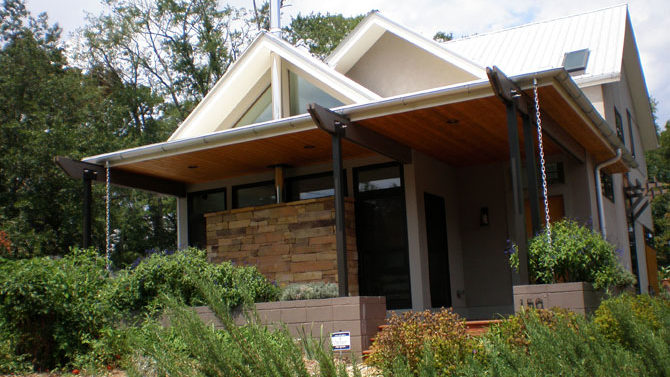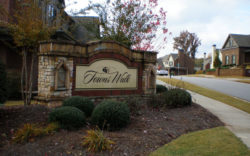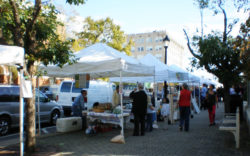Imagine, in the early afternoon, walking from room to room, never having to turn on a light switch. It’s mid-summer, and you’re not even using air conditioning! Then, in the middle of winter, your heating bill is half what the typical Athens household pays. All that is a reality if you live in one of the several homes in Athens designed for energy efficiency.
 Buildings are being retrofitted to include green construction materials using environmentally sensitive design techniques. And, with good reason, many newly constructed buildings are, too. Although upfront costs are higher than an energy-demanding alternative, the cleaner option pays for itself over time, and more and more quickly as increasing worldwide demand causes energy prices to continue to rise. Also, green tech buyers can opt into state tax breaks for these purchases.
 What about the design makes it green? I found out touring houses by builder Dennis Mason and architect Lori Bork Newcomer. Windows take advantage of the sun’s natural light and heating. Overhangs from the roof regulate the amount of heat from the sun entering the house; they block the heat of the sun in the summer because of the high arc of the solar disc, whereas in the winter, the sun’s lower arc gives it a straight shot for heating up your living space. Walking through environmentally conscious buildings, I’ve greatly enjoyed the ambiance this design creates. Being one who favors natural lighting, I appreciate windows whose placement allows the sunlight to deeply penetrate the living space, minimizing the need for artificial light and its irksome, unsettling mood.Â
 But green design is more than just a few strategically placed windows. It’s the whole layout. It begins by accounting for the site’s natural elements, such as the arc of the sun and the shade of the trees, as well as energy-efficient materials. These buildings use special concrete to retain heat during the winter and keep it out during the summer, along with windows that help maintain a house’s desired temperature.
 Buildings also can have their own alternative energy contraptions to reduce their carbon footprint (and monthly energy bills). While they may have a lofty upfront cost, these devices pay for themselves and then some over time. Not to mention, they may increase resale value of the house.
 So, you want to renovate or build a house that will save the environment and save you money? Great! Even if you have to finance the project, I say “go for it.” You’ll come out ahead in the long run while decreasing your environmental impact. Plus, green building techniques can improve your quality of life. Who wants to listen to the drone of a noisy air conditioner all summer long? Or turn on that unflattering indoor lighting?
 Leadership in Energy and Environmental Design is a certification program that grades buildings on following its prestigious standards and tests the house to ensure the systems are functioning properly. LEED is the real deal; no “greenwashing” here. But is the hefty price tag worth it? Yes, LEED requires certain features, such as landscaping with drought-resistant plants, that the builder with even the best intentions might overlook. Plus, you get the satisfaction of knowing you’re doing what you can to diminish your energy and water consumption.
 Looking to the future, what’s next for green design? Already, the government regulates energy efficiency to some degree. Houses must pass an air retention test before being occupied. I hope for and expect increased energy-efficiency standards or tax breaks rewarding green building. But our very own Gov. Nathan Deal recently declared that no state-funded building will be LEED certified because LEED doesn’t recognize most Georgia forests as acceptable to use in its projects, even though LEED supports using local materials. So much for that idea.
 Still, consumers are already demanding green design. Perhaps if our politicians hear from those who favor this kind of development, they’ll be more likely to reconsider their position. (At least we can hope so.) Thankfully, major institutions like the Athens-Clarke County government and the University of Georgia set an exemplary standard of green design. After seeing how they have succeeded, hopefully businesses and other organizations will follow suit.
 Now is the time for innovation and advancement. As U.S. Energy Secretary Steven Chu said, “The Stone Age did not end because we ran out of stones; we transitioned to better solutions. The same opportunity is before us with energy efficiency and clean energy.†We should progress to these cleaner, healthier options now before we’ve lapsed further into an energy crisis.
 As Athenians, we pride ourselves on innovative and environmentally aware lifestyles. We bring our own bags to the grocery store; we walk or bike where we can; we go the extra mile to recycle a bottle. And now we build and renovate our homes to further reduce our carbon footprint.
Like what you just read? Support Flagpole by making a donation today. Every dollar you give helps fund our ongoing mission to provide Athens with quality, independent journalism.










